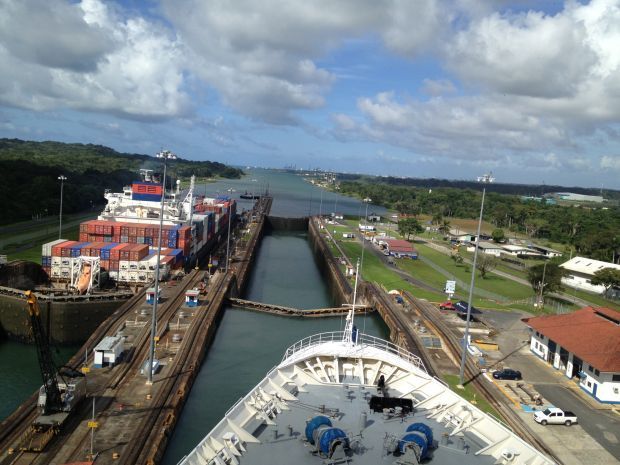Going to the Panama Canal has always been on our bucket list, especially Gene’s. So, on Nov. 30 we and our good Phoenix friends, the Laurels, boarded Royal Caribbean’s ship, Legend Of The Seas, in San Diego for a 16-day cruise and made it happen.
Along with visiting the canal, we stopped in Mexico’s Cabo San Lucas and Puerto Vallarta, Puerto Quetzal, Guatemala, Puntarenas, Costa Rica, Colon, Panama and Cartagena, Columbia. Sixteen days on a ship with 1,750 of our best friends and a crew of 726 representing nearly 80 countries and 30 languages made the cruise very comfortable, stress-free and relieved from emails and phone calls.
Prior to our arriving at the canal, Guatemala’s highlights included a visit to La Antigua, a UNESCO World Heritage Site, famous for its well-preserved Spanish-influenced architecture and the surrounding mountains and volcanoes.
Costa Rica’s highlights featured its rainforests, an eco-paradise, exotic birds and century-old trees. We fed bananas to hungry white-faced monkeys. On a river cruise, we anxiously watched our river’s pilot leave the boat and fed raw chicken to some crocodiles patiently waiting for their noon-time snack.
On the early morning of the 11th day of the cruise, the canal came into view with Panama City reflecting an impressive sight of skyscrapers that rivaled Dubai. Cargo ships lying at anchor awaited their turn to cross the canal. As we stood at the bow of the ship and watched the beginning of the crossing, a running description of what was happening was broadcast for us.
This was the 100th anniversary of the 48-mile ship canal that connects the Pacific Ocean via the Caribbean Sea to the Atlantic Ocean. It took an additional 10 years to build it after the U.S. took it over from a failed French consortium in 1904. It cuts across the Isthmus of Panama and is the key conduit for international maritime trade with 14,000 vessels crossing the canal each year averaging 35 to 40 ships a day; its crossing usually takes 8 to 10 hours.
Prior to its construction in 1914, ships from both oceans had to sail around the Cape of Good Horn, a voyage which was hazardous and time-consuming. Consequently, the shorter, faster passage offered a boon to the world economy.
There are locks at each end to lift ships up and down to sea level via the Miraflores and Pedro Miguel locks on the Pacific side and the three Gatun locks on the Atlantic side. These locks lift ships up and down 85 feet to the Gatun Lake, one of the world’s largest artificial lakes, created by damming of the Chagres River. The lake is an essential part of the canal which forms the water passage between the two oceans. Observing these ships transiting east and west is truly a remarkable engineering feat, a testimony to our country’s engineers and our industrial know-how and capacity. The American Society of Civil Engineers has named the canal one of the seven wonders of the modern world.
An additional channel is being built by the Panama Canal Authority (PCA) which almost parallels the current navigational channel and deepens the Pacific’s and Atlantic’s canal entrances. When finished by early 2016, it will provide a canal that accommodates the larger maritime vessels that are unable to transit. The current locks are only 110 feet wide. Its expansion will provide a third set of locks that will offer a reliable route for all ships regardless of size.
Passing through the canal on the Atlantic Ocean, our ship arrived in Colon, Panama. It originally served as the gateway for the Transcontinental Railroad across the Isthmus of Panama. With the California gold rush of the 1890s, it served thousands of people flocking to California via Panama. With the canal being constructed, it flourished again. Today, a free-zone exists in Colon which permits a duty-free economy available to countries selling their goods.
We arranged for a private tour which took us overland to back to Panama City. We toured old Panama City and visited the presidential palace. Driving into new Panama City, we immediately were brought into a modern city, freeways, skyscrapers and a bustling economy.
The U.S. controlled the canal and surrounding Panama Canal Zone until the 1997 Torrijos-Carter treaties. The two countries had joint control until 1999 but is now exclusively managed and operated by the PCA. Today, Panama enjoys democracy and economic prosperity considered to be the strongest and most viable in South America.
Our guide, Roberto, a native of Colon, was remarkable in his knowledge of Panama and the canal’s operation. Near the end of the tour, we visited a museum operated by the PCA with an emphasis on the ongoing construction of the new channel. Observing the construction from the museum, we could see first-hand its quality and efficiency.
Leaving Colon, the ship cruised to Cartagena, Columbia. Arriving there the next day, we again were aghast at seeing another sight of a modern city. Like Panama City, Cartagena contains the old and the new. The old, a walled city which was originally built to protect itself from invaders, also had the San Felipe Fortress, originally constructed in 1536 and finished 200 years later. Its construction, built without modern machinery defied our imagination as to its stability and design. Shops lined with Columbian goods became strong magnets for us.
Sadly, the cruise was ending as it made the last two days back to Ft. Lauderdale. It was a most relaxing time, reviewing what we had seen and done over the past two weeks, attempting to recover our casino losses and knowing that the cruise’s food, some of its specialty restaurants, would not be around to enhance our expanding waist lines.
We believe the best way to describe this cruise is a quote from one of our son’s friends: “You can’t put a price on a good time.”
